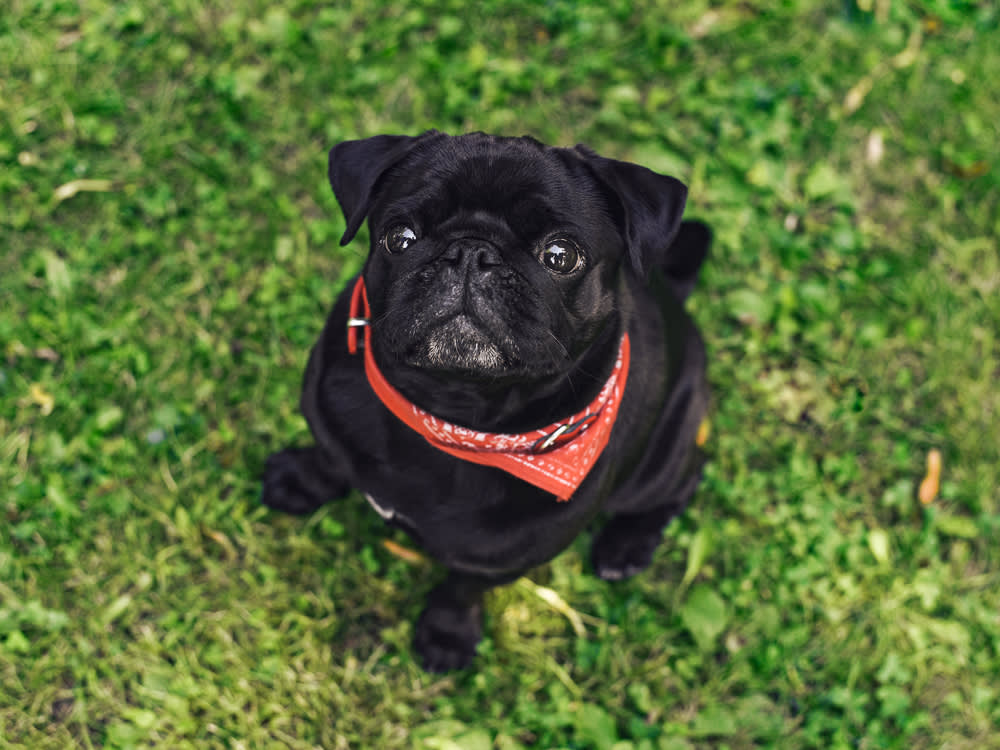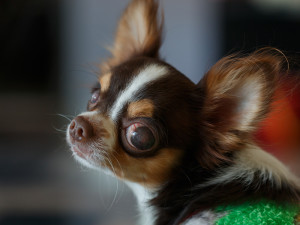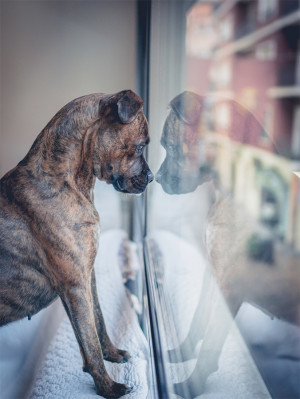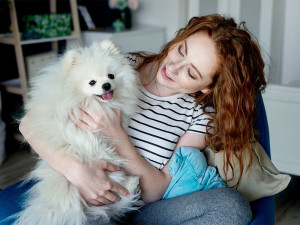Everything You Need to Know About Cataracts in Dogs
Here’s how to spot the eye condition and help your dog see more clearly
When you look into your dog’s eyes, what do you see? Besides the one true object of their desire – that peanut butter treat you’ve been hiding from them on top of the fridge – you don’t want to see cloudy eyes. If your dog is healthy, you should see bright, shiny, clear eyes looking back at you.
Do cloudy eyes mean my dog is blind?
If your dog’s eyes look a little cloudy or bluish-grey, it could mean that cataracts (clouded-eye lenses) are forming. Cloudy eyes don’t always indicate cataracts in dogs, but you shouldn’t ignore them – it’s best to take your dog to the vet to be checked out for canine eye disorders. In the meantime, keep reading to learn everything you need to know about cataracts in dogs, including how to treat them.
What are cataracts in dogs?
Cataracts in dogs are characterised by opacity in the lens of the eye (basically, a cloudy film keeps light from entering the eye). The lens is the normally clear structure that sits directly behind the iris (the coloured part of the dog’s eye), and its job is to focus light as it moves toward the back part of the eye (the retina). Despite its clarity, the lens is in fact made of tissue fibres. As a dog ages, these fibres become more dense and compact, preventing the passage of light to the retina, leading to blindness.
Can dogs live comfortably with cataracts?
Many dogs do live comfortably with cataracts for many years. It’s not the cataracts themselves that are painful – it’s the secondary conditions, such as glaucoma, that can cause discomfort.
What causes cataracts in dogs?
Cataracts in dogs are usually hereditary. Other causes of cataracts in dogs include congenital (a dog who is born with it), senile cataracts (age-related), diabetes, trauma, dietary deficiency (milk replacement formulas that are low in arginine or phenylalanine have been implicated as well as puppies fed strictly evaporated milk formulas or goats milk), electric shock or toxins.
Genetics
Genetics is the most common form of cataracts in dogs. These cataracts impact much younger dogs, with juvenile cataracts affecting over 100 breeds, most commonly Poodles, Boston Terriers, French Bulldogs and Staffordshire Bull Terriers. If these breeds inherit cataracts, they can develop them as young as eight weeks.
Age
One of the causes of cataracts in dogs is ageing. This type of cataract usually affects dogs over four, with the average age being nine years old. Yorkshire Terriers are the most common breed to develop age-related cataracts. Research found that the incidence of cataracts was directly related to the relative life expectancies in breed groups: the smallest dog breeds had a lower likelihood of cataracts between ages four and five than mid-sized breeds. Mid-size breeds had a lower prevalence than big breeds.
Diabetes
Another common cause of cataracts in dogs is diabetes. High blood sugar (glucose) in the lens is converted to sorbitol, which draws water into the lens. This causes the lens to swell, resulting in disruption of lens fibres and oxidative stress, which results in cataracts. About 75–80 percent of diabetic dogs will develop cataracts within the first year of their diagnosis, regardless of how well-controlled their diabetes is.
Injury
Injury to the eye is another common cause of cataracts in dogs. This will happen if the lens capsule is ruptured due to trauma that penetrates it. Traumatic cataracts may also occur following contusion in which case they may not develop until several weeks after the injury occurred.
What are the symptoms of cataracts in dogs?
Cloudy eyes are just one of the symptoms of cataracts in dogs – here are some of the other common signs.
Cloudiness in eye
One of the telltale signs of a cataract is a cloudy appearance with a white, grey or blue tint. This opaqueness can cover one or both eyes and either a small surface area or the entire lens.
Sensitivity to light
Cataracts are caused by cloudy lenses. Because they aren’t clear, cataracts make it hard for light to get through lenses clearly. Light scatters off the cataracts, causing glare and discomfort in bright sunlight.
Blurry vision
When your dog has cataracts, the cloudiness blurs their vision. Your dog may be clumsier than normal, bump into objects, or have trouble navigating around the home and yard.
How to treat cataracts in dogs?
Dog cataract treatment generally involves surgical removal or physical dissolution (‘breaking up’) of the cataract under anaesthesia. The ideal time for cataract surgery in dogs is the immature or early mature cataract stage. Of course, your dog must also be in good general health to undergo treatment. For example, a diabetic dog must be well regulated before cataract surgery. Also, in order for a dog to be a good surgical candidate, they must also have a temperament conducive to having eye drops administered at home. Lab work is performed prior to anaesthesia and some ophthalmologists also request that pets have their teeth cleaned prior to surgery to minimise sources of infection in the eye.
Historically, removing the cataract meant surgically cutting into the eye and physically removing the lens. This is still done for older patients whose lenses are compact, but for younger patients where the lens is still soft, a technique called phacoemulsification is preferred.
Phacoemulsification has become the most common method of removing cataracts in dogs. With phacoemulsification, the lens is broken apart by sound waves and sucked out with a gadget similar to a tiny – a few millimetres wide – vacuum cleaner. Artificial lenses are implanted at the time of surgery, restoring essentially normal vision. (Without the artificial lens, the dog’s vision will be approximately 20/800, and objects will appear to be reversed, as in a mirror.)
Cataract surgery for dogs is performed routinely with an overall 80 to 90 percent success rate. Long term prognosis following cataract surgery is very good to excellent. Overall, a 95 percent vision rate is reported immediately after cataract surgery, and once cataracts are removed from a dog’s lens, they cannot return.
What happens if you don’t treat cataracts in dogs?
A cataract by itself does not necessarily require treatment. If the only problem is blindness, and there is no associated inflammation or glaucoma, you could leave it alone. Blind dogs can have an excellent quality of life and can adjust well to vision loss (though it’s important not to move furniture around or leave any hazardous clutter around the house). Some dogs, however, do become anxious – or even aggressive – when they lose their vision.
A bigger concern is that a cataract can luxate, meaning it can slip from the tissue strands that hold it in place and end up floating around in the eye, causing damage. On top of that, if a cataract settles in a place blocking the natural fluid drainage of the eye, they can get a buildup in eye pressure (glaucoma), leading to pain and permanent blindness. Another problem is that cataracts can begin to liquefy and dissolve after a long time. While this sounds like it should be a good thing, it is a highly inflammatory process, and it creates a condition called uveitis. This is a very painful eye disease that can also lead to glaucoma.
What else could cause cloudy eyes?
During exams, pup parents often raise the concern that a cataract is developing in their dog’s eye. Generally, the vast majority of the time the dog does not have cataracts, but instead has the much more common canine eye condition known as nuclear sclerosis. Nuclear sclerosis in dogs is a normal change that occurs in the lenses of older dogs, and it appears as a slight greying of the lens. The older, denser lens begins to appear cloudy. Nuclear sclerosis in dogs usually occurs in both eyes at the same time and occurs in most dogs who are more than six years old. The condition does not significantly affect vision and treatment is not needed.
Your vet can tell the difference between a cataract and nuclear sclerosis by shining a bright light into the eye. In a dog with a cataract, you are unable to see to the back of the eye (the retina); with nuclear sclerosis, you can still see the retina. Nuclear sclerosis can easily be mistaken for a cataract at first glance, so you’ll want to consult a professional for this one.
If you see cloudiness in one or both of your dog’s eyes, make a trip to the vet. Your veterinarian can perform a complete physical examination, focusing on the eyes, helping to determine the severity of the problem. Next, you can decide the right next steps, considering budget and benefits of treatment. In the end, like everything, it’s a personal decision – and one your dog trusts you to make.
Frequently asked questions
Can dogs live comfortably with cataracts?
Many dogs do live comfortably with cataracts for many years. It’s not the cataracts themselves that are painful; it’s the secondary conditions that are painful.
How long can dogs have cataracts before they go blind?
It depends on the type of cataracts: Diabetic dogs have a 75 percent chance of developing cataracts, and 75 percent of those that do will lose their vision within 6–12 months if left untreated.
What happens if you don’t treat cataracts in dogs?
If cataracts aren’t treated in dogs, it can become painful and ultimately lead to blindness.
How to fix cloudy eyes in my dogs?
If the cloudiness is caused by cataracts, dog cataract treatment generally involves surgical removal or physical dissolution (‘breaking up’) of the cataract under anaesthesia.
Do cloudy eyes mean my dog is blind?
Not necessarily – however cloudy eyes are a sign of cataracts, so get your dog checked to ensure that they get the proper treatment.
References:
A Retrospective-Cohort study on the development of cataracts in dogs with diabetesopens in new tab
Ocular manifestations of diabetes mellitus: Diabetic cataracts in dogsopens in new tab
Prevalence of primary breed-related cataracts in the dog in North Americaopens in new tab
Cataracts in Dogs: The Importance of Early Detection and Managementopens in new tab







